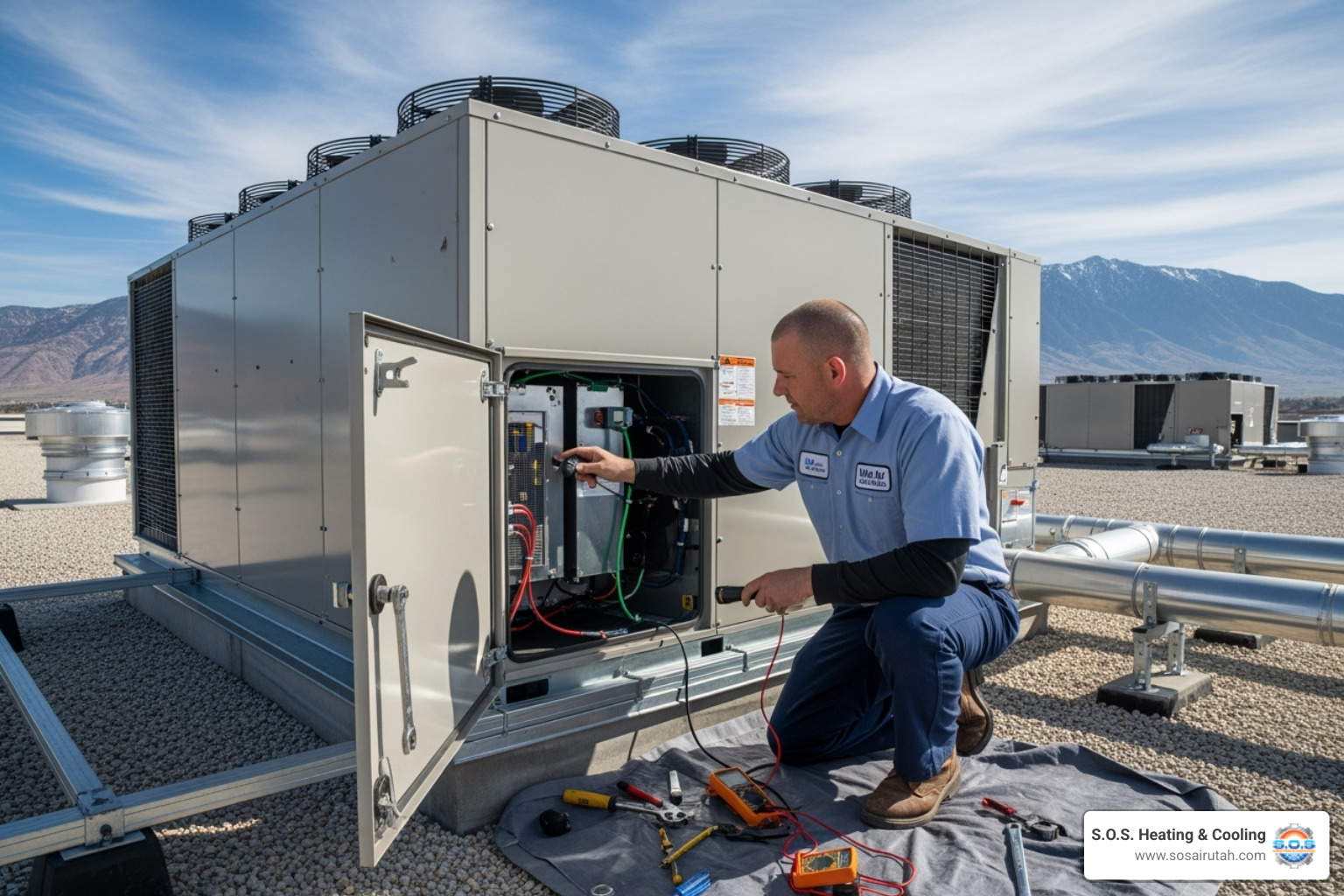
During the heat of late August in Layton, a failing AC system can quickly turn from a minor annoyance into a major disruption. If your air conditioner is running but your home still feels warm, the problem might be with the condenser fan motor. This part plays a big role in helping the AC push out hot air collected from inside your home. When it’s not working like it should, the whole system starts struggling to do its job.
The motor in your outdoor AC unit isn't something most homeowners think about until something goes wrong. But when this motor burns out or starts slowing down, it can take a toll on your comfort. Ignoring the early signs usually makes the issue worse. Understanding what this component does and what happens when it fails will help you know what steps to take next.
Signs Of A Failing AC Condenser Fan Motor
When the condenser fan motor starts giving out, signs begin to show. Catching the issue early can help prevent additional damage to the entire AC system. This is especially important during late summer months in Layton, when your system is likely running more often and under more stress.
Here are some common signs that may point to this issue:
- The fan in your outdoor unit doesn’t spin, even when the system is running
- You hear strange noises like buzzing, clicking, or humming coming from the outdoor unit
- Your house doesn’t feel as cool as it should, even after the system’s been on for a while
- The AC shuts off before cooling the home or keeps running without a break
- You notice warm air blowing from the vents when the system is set to cool
It’s helpful to pay attention to patterns. For example, a homeowner in Layton noticed their unit making a humming sound every time it kicked on, but the fan wasn’t turning. After a short while, the whole system would shut down. When they had a technician inspect the unit, the condenser fan motor had failed completely and was overheating the system.
If you spot one or more of these signs, it’s time to get the issue checked. Allowing the unit to keep running under strain often leads to higher energy costs and possible compressor damage, which can be much more expensive to address.
Common Causes Of Condenser Fan Motor Failure
Several things can lead to a condenser fan motor going bad. These causes tend to build up over time and usually go unnoticed until the motor stops working. Knowing the root causes can help homeowners in Layton minimize wear on their units and improve the system’s overall performance.
The most common reasons include:
1. Electrical problems: Breaker trips, failing capacitors, or wiring damage can prevent power from reaching the motor. This keeps it from starting or causes it to shut off when it shouldn’t.
2. Motor overheating: If the fan motor gets too hot, it may eventually shut down or burn out completely. Poor airflow around the unit or debris inside the system often make this worse, especially during warmer months.
3. Lack of maintenance: Neglecting seasonal AC check-ups leads to dirt buildup, worn wiring, or loose parts that can damage the motor over time. Dry bearings or lack of lubrication also put extra stress on motor components.
4. Age and wear: Motors don’t last forever. If your AC unit is older and the motor has never been inspected or replaced, age might be the biggest factor. Older motors are more likely to fail due to parts breaking down from long-term use.
The condenser fan motor is responsible for pulling outdoor air across the condenser coil, which helps remove heat from your home. If any of these issues cause the motor to stop working right, your home cooling takes a hit and so does the health of the entire system. That’s why understanding the cause is just as important as recognizing the symptoms.
Diagnosing and Repairing AC Condenser Fan Motor Issues
When you start noticing signs of AC trouble, such as weak airflow or loud humming noises from the outdoor unit, it usually means something specific is going wrong. Many homeowners in Layton are surprised to learn that condenser fan motor problems can be diagnosed early if you're paying attention to the right things.
For starters, check if the fan blades on the outdoor unit are spinning when the AC kicks on. If they’re not moving, spinning slowly, or stopping after a few seconds, that's an early red flag. Another sign is when the system seems to start but doesn’t cool the air inside your home. That disconnect between the system running and cool air being delivered often points to a faulty fan motor or related electrical failure.
Trying to open your unit or troubleshoot complicated components without training can lead to harmful outcomes or more damage. Hiring our professionals allows you to avoid possible safety risks and ensures a proper fix. Our professionals use specialized tools to test run capacitors, inspect wiring, measure voltage, and verify motor resistance. These are steps most homeowners shouldn’t try on their own.
Depending on the diagnosis, repairs may include:
- Replacing the fan motor itself if it has failed or shows serious wear
- Installing a new capacitor if the current one isn't supplying enough power
- Repairing or replacing faulty wiring connections
- Cleaning the fan blades or clearing physical obstructions that prevent rotation
In more serious cases where the motor has completely died or has damaged other parts of the unit, a full motor replacement might be recommended. Acting fast keeps the problem from spreading to other key components like the compressor. When the fan stops doing its job, heat builds up and puts pressure on the entire system. That’s why repairs should be scheduled as soon as the issue is confirmed.
Preventative AC Maintenance For Long-Term Reliability
The best way to avoid condenser fan motor failures in Layton is to stay one step ahead. Regular AC maintenance may sound routine, but it goes a long way in extending the life of your system and avoiding emergency problems when the weather’s hot.
Here are a few ways homeowners can help keep their system running properly:
- Clear leaves, grass, and debris away from the outdoor unit
- Make sure there’s at least two feet of space around the unit for airflow
- Listen for odd sounds or changes in performance and schedule a service check if anything feels off
- Replace your HVAC filter routinely so airflow isn't restricted inside the system
- Avoid pushing the system too hard during peak heat by using ceiling fans to help circulate cool air
In addition to homeowner care, routine service visits matter. Our technicians inspect all parts of your unit during an annual check-up, including the fan motor, wiring, and capacitors. These service visits make it easier to spot wear early, apply basic corrections, and keep the AC system running efficiently through the hottest parts of the year.
Skimping on maintenance often leads to larger and more expensive repairs later. For example, during a service call in Layton, a home’s outdoor unit was found packed with leaves and grass clippings around the condenser. The motor had started overheating from blocked airflow and was drawing excess power. Clearing out that debris and catching the issue early prevented more extreme damage to the entire system.
Protecting Your Comfort With Timely AC Repairs In Layton
Late summer heat can make AC system strain even worse, especially when an issue like fan motor failure is involved. Ignoring the signs like loud noises, weak airflow, or a fan that won’t start often turns a small fix into a serious breakdown. Addressing the problem quickly keeps your system running smoothly and your home comfortable.
Condenser fan motors play a key part in keeping your AC system balanced. If that part fails, it’s only a matter of time before other components are pushed past their limit. Avoiding surprise breakdowns starts with maintenance and continues with fast action when something seems off. With the right attention and professional help, homeowners in Layton can keep cool even during the hottest months.
If your air conditioner is struggling to keep your home cool due to a malfunctioning condenser fan motor, prompt professional support can make all the difference. S.O.S. Heating & Cooling offers dependable AC repair in Layton to restore your comfort and system performance. For a quick estimate or to book a service visit, please contact us today.
Explore Our Latest Insights and Updates in Plumbing Services

Salt Lake City Home Air Quality: What You Need to Know About Testing

When Your Water Heater Quits: Emergency Repair Solutions for Utah Homes

Stay Productive with Expert Commercial AC Maintenance for Utah Businesses






.avif)